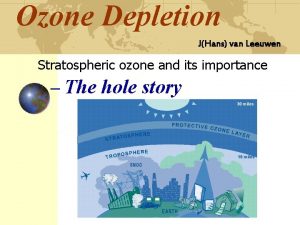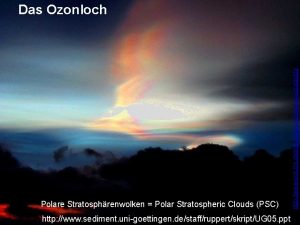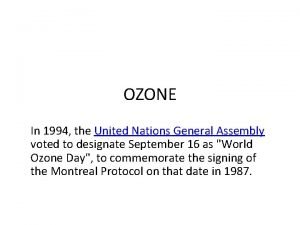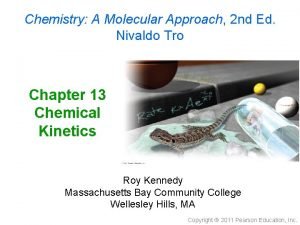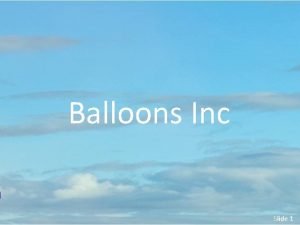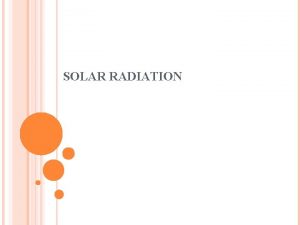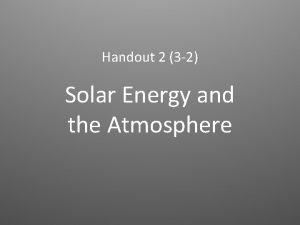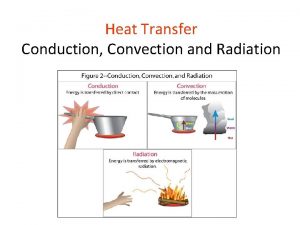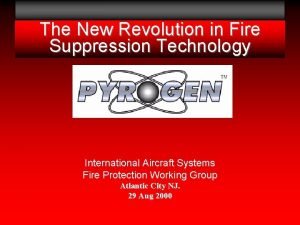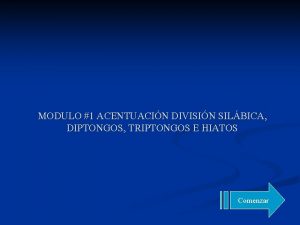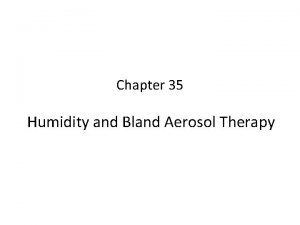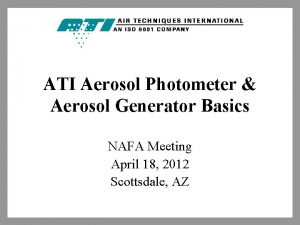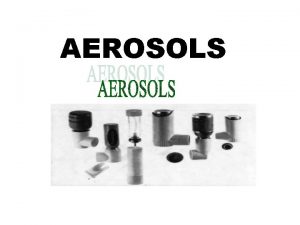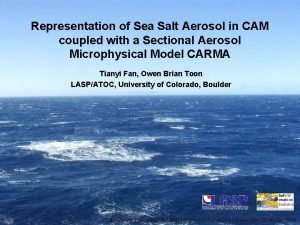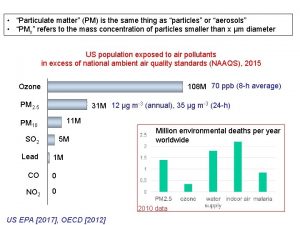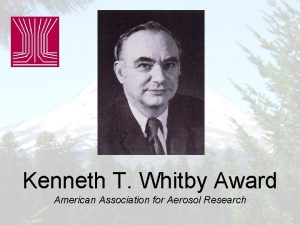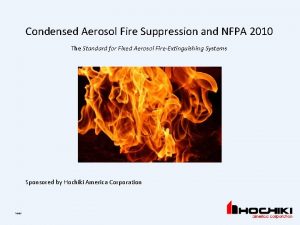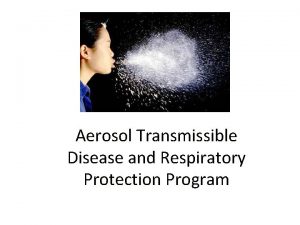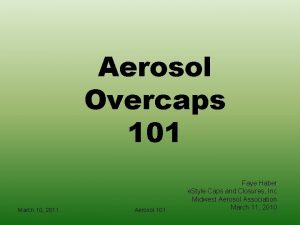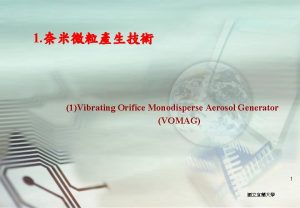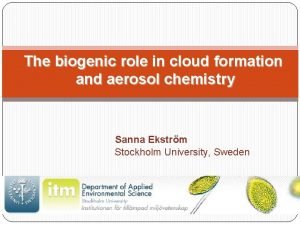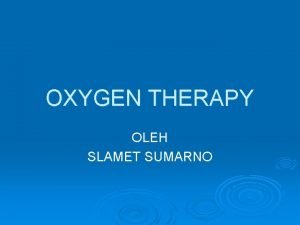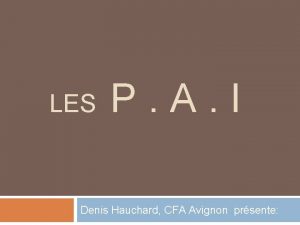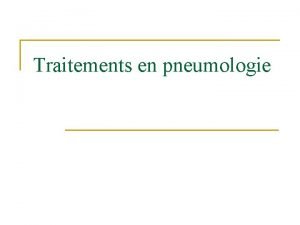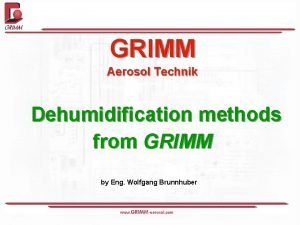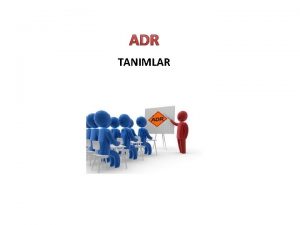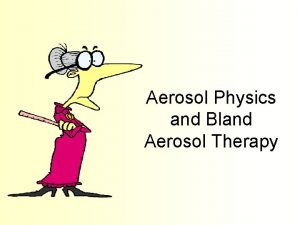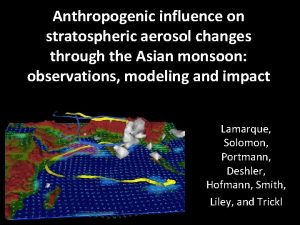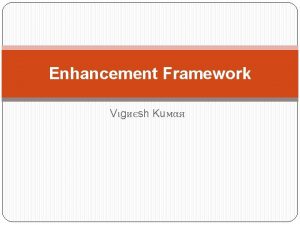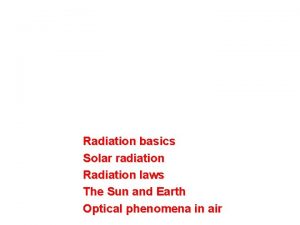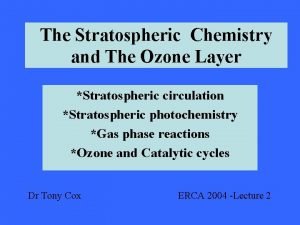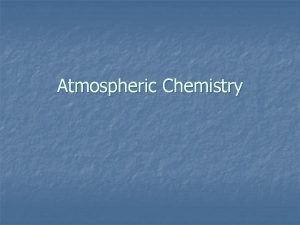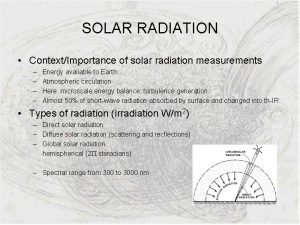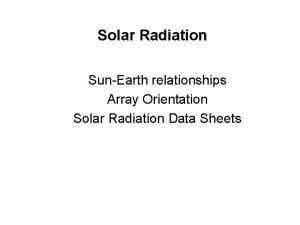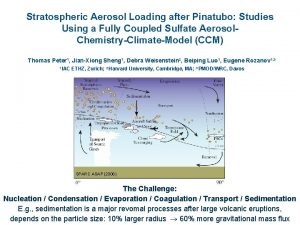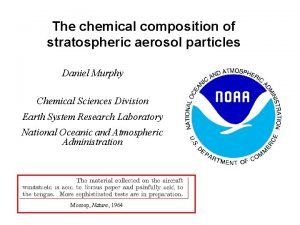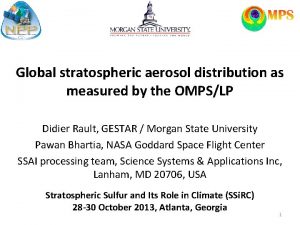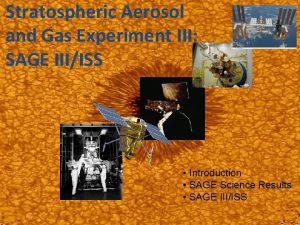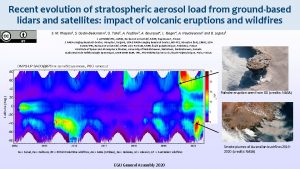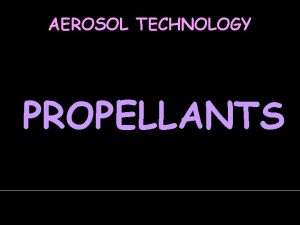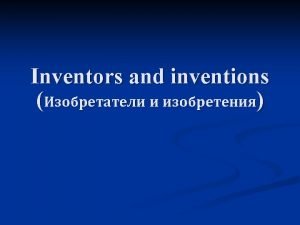Solar radiation management through stratospheric aerosol enhancement Greg



































- Slides: 35

Solar radiation management through stratospheric aerosol enhancement Greg Bodeker Scientific, Alexandra, New Zealand Presented at ‘Geoengineering the Climate? A Southern Hemisphere perspective’, Canberra, 26 -27 September 2011

Overview • How does solar radiation management through sulfate aerosol enhancement (SAE) work? • What technologies are available to implement it? • How do the effects of SAE and CO 2 reduction on climate differ? • What are the advantages of SAE? • What are the disadvantages of SAE? • Conclusions

How sulfate aerosol enhancement cools climate A solar reduction of 1. 7% would compensate for the global mean warming effect of a doubling of atmospheric CO 2

How sulfate aerosol enhancement cools climate Sulfate aerosol particles are not the only option. For non electrically conducting particles, need particles of a few tenths of a micron, 0. 1μm is likely optimum. Aerosol size distribution has to be managed against coagulation. Conducting particles or resonant scatterers may have potential to deflect sunlight with much less mass, but these approaches have been subjected to much less analysis. Engineered aerosols (nanotechnology) might enable scattering that does not produce so much diffuse illumination. They may also avoid the coagulation and vaporisation problems encountered by sulfate aerosols. Most research on sulfate particles.

Sulfate aerosol enhancement technologies Must get sulfur to the stratosphere. Can consider H 2 S. More S per kg of gas. Only 1 Mt of H 2 S would be required to produce the same amount of sulfate aerosols as 2 Mt of SO 2. H 2 S is quickly oxidized to SO 2, which then reacts with water to form H 2 SO 4 droplets. However, H 2 S is toxic and flammable, so it may be preferable to use SO 2. Biggest technological hurdle at this stage is how to produce particles of the right size. Size distribution matters and coagulation and sedimentation will constantly erode the ideal size distribution. Delivery of 1 to 5 Mt. S/year to the stratosphere is technologically feasible.

Sulfate aerosol enhancement technologies Depends on the required delivery altitude – tropical lower stratosphere, so around 20 km. Custom built fleet of aircraft. Balloons. To put 1 Mt. S into the stratosphere would require around 37, 000 of the largest standard weather balloons per day. What goes up must come down – trash rain. Height limit for carbon/epoxy composite tower is 114 km.

SAE CO 2↓ How do the effects of SAE and CO 2 reduction on climate differ? – timescales SAE acts on very different time-scales to increases in GHG concentrations. Because of its long atmospheric lifetime, a unit mass emission of CO 2 imposes a radiative forcing on the climate for many decades committing the global economy to a multidecade programme of SAE.

SAE CO 2↓ How do the effects of SAE and CO 2 reduction on climate differ? – pattern of radiative forcing Bala. G. , Problems with geoengineering schemes to combat climate change, Current Science, 96, 41 -48, 2009. While the cancelation in the global mean is complete, this is not true for any particular location. There will be residual net impacts on regional climates.

SAE CO 2↓ How do the effects of SAE and CO 2 reduction on climate differ? – pattern of temperature response Top panel shows change in surface temperature for a doubling of CO 2 and bottom panel shows the same after an additional 1. 84% reduction in global mean solar radiation. So why not just add more sulfate aerosols to polar regions? Caldeira K & Wood L (2008). Global and Arctic climate engineering: numerical model studies. Philosophical Transactions of the Royal Society A 366, 4039– 4056.

Advantages of sulfate aerosol enhancement – effective There are no technological barriers to implementing SAE and no inherent limit in its ability to mitigate changes in global temperatures. Matthews H. D. and S. E. Turner, Of mongooses and mitigation: ecological analogues to geoengineering, Env. Res. Lett. , 4, doi: 10. 1088/17489326/4/4/045105, 2009.

Advantages of sulfate aerosol enhancement – affordable Very inexpensive compared to carbon dioxide removal methods. Setup costs on the order of a few billion US$. Costs on the order of 3 to 30$/kg so a few billion to a few tens of billions of US$ annually, although this does not include the environmental costs of implementing the programme. Close to typical annual profit made by Exxon. Mobil.

Advantages of sulfate aerosol enhancement – reversible If unforeseen side effects of SAE become apparent, or if SAE is no longer required (e. g. because atmospheric GHG concentrations are reduced through other policies), it can be halted quickly; the e-folding time for stratospheric aerosols is about one year. However – can we be sure that there is no hysteresis in the system? Will the path coming back from SAE be the same as the path going out?

Advantages of sulfate aerosol enhancement - timely With the necessary financial investment, SAE could be implemented within the next years to a decade.

Advantages of sulfate aerosol enhancement - photosynthesis Increase in stratospheric aerosol loading reduces direct solar radiation and increases diffuse. Dutton, E. G. , and B. A. Bodhaine (2001), Solar Irradiance Anomalies Caused by Clear-Sky Transmission Variations above Mauna Loa: 1958– 99, J. Climate, 14, 32553262. Gu et al. (2003), Response of a Deciduous Forest to the Mount Pinatubo Eruption: Enhanced Photosynthesis, Science, 299, 2035 -2038. Change in the direct/diffuse ratio allows plant canopies to photosynthesize more efficiently thereby increasing their capacity as a carbon sink.

Advantages of sulfate aerosol enhancement - photosynthesis Evidence from the El Chichon and Pinatubo volcanic eruptions on net primary productivity Mercado et al. (2009), Impact of changes in diffuse radiation on the global land carbon sink, Nature, 458, 1014 -1018.

Advantages of sulfate aerosol enhancement – tuneable and scalable It may be possible to inject aerosols only into one region of the stratosphere (e. g. the high latitudes) and only during certain months of the year to fine-tune the effects on surface climate. SAE would need to be steadily increased to cope with rising 5 Mt SO 2/Year atmospheric CO 2 levels. Jones et al. (2010), Geoengineering by stratospheric SO 2 injection: results from the Met Office Had. GEM 2 climate model and comparison with the Goddard Institute for Space Studies Model. E, Atmos. Chem. Phys. , 10, 5999– 6006.

Disadvantages of sulfate aerosol enhancement – ozone depletion Fahey, et al. (1993), In situ measurements constraining the role of sulphate aerosols in mid-latitude ozone depletion, Nature, 363, 509 -514.

Disadvantages of sulfate aerosol enhancement – ozone depletion Expected return of Antarctic ozone to 1980 levels could be delayed by 30 -70 years. Aerosol heating, in particular at the tropical tropopause, could also increase H 2 O flux to the stratosphere which would cause stratospheric ozone loss. Tilmes, S. , R. Müller, and R. Salawitch, The sensitivity of polar ozone depletion to proposed geoengineering schemes, Science, 320 (5880), 1201 -1204, doi: 10. 1126/science. 1153966, 2008 a

Disadvantages of sulfate aerosol enhancement – ozone depletion What were the effects of the Mt. Pinatubo volcanic eruption on ozone? Large response in northern midlatitude ozone but no discernible response in southern midlatitude ozone. Update of Bodeker, G. E. , B. J. Connor, J. B. Liley, and W. A. Matthews (2001), The global mass of ozone: 1978 -1998, Geophys. Res. Lett. , 28(14), 2819 -2822.

The ozone hole matters for climate in Australia Kang, S. M. , L. M. Polvani, J. C. Fyfe, and M. Sigmond (2011), Impact of Polar Ozone Depletion on Subtropical Precipitation, Science, 332, 951 -954.

Disadvantages of sulfate aerosol enhancement – regional climate change SAE modulates incoming short-wave solar radiation, as opposed to GHGs which modulates outgoing long-wave terrestrial radiation. Diurnal, seasonal and spatial pattern of the radiative forcing change through SAE is quite different to that resulting from atmospheric accumulation of GHGs. In particular they have different effects on the temperature lapse rate. This drives changes in the hydrological cycle. Model simulations suggest that significant changes in regional climate would be experienced even if geoengineering was successful in maintaining global mean temperatures near current values.

Disadvantages of sulfate aerosol enhancement – regional climate change Jones et al. (2010), Atmos. Chem. Phys. , 10, 5999– 6006.

Disadvantages of sulfate aerosol enhancement – regional climate change Robock et al. (2008), Regional climate responses to geoengineering with tropical and Arctic SO 2 injections, JGR, 113, D 16101, doi: 16110. 11029/12008 JD 010050. In general reducing solar radiation to keep temperature constant reduces precipitation. This will produce warming from drier surfaces requiring even more solar reduction and more drying. Various studies suggest SAE might modify the Asian and African summer monsoons, reducing precipitation and potentially impacting the food supply to billions of people.

Disadvantages of sulfate aerosol enhancement – continued ocean acidification CO 2 emissions would likely continue and because about half of excess CO 2 in the atmosphere is taken up by the ocean, progressive ocean acidification will threaten ocean biology.

Disadvantages of sulfate aerosol enhancement – sky whitening By scattering incoming solar radiation in a way very different to Rayleigh scattering, aerosols in the stratosphere would whiten the sky. Planning simulations with MYSTIC radiative transfer model. Psychological impact of no blue sky? But what better banner for the need for GHG emissions reduction.

Disadvantages of sulfate aerosol enhancement – reduced solar power generation While the total surface irradiance would decrease by only 1. 5 -2%, the change in the direct/diffuse ratio will significantly reduce solar power generation from many facilities that rely on focussing direct beam irradiance. -34% Robock, A. (2000), Volcanic eruptions and climate, Rev. Geophys. , 38(2), 191 -219.

Disadvantages of sulfate aerosol enhancement – uncertain exit strategy If maintaining a SAE programme becomes economically prohibitive and is abruptly terminated, extremely rapid warming would follow. Robock, A. , L. Oman, and G. L. Stenchikov (2008), Regional climate responses to geoengineering with tropical and Arctic SO 2 injections, J. Geophys. Res. , 113, D 16101, doi: 16110. 11029/1 2008 JD 010050.

Disadvantages of sulfate aerosol enhancement – control Because the effects of SAE will be regionally different, how will the optimum level of stratospheric aerosol loading be determined? Should the parties funding the programme have the freedom to optimize their climate at the expensive of others? Governance.

Disadvantages of sulfate aerosol enhancement – others Adverse effects on space-based measurements of atmospheric composition. Will interfere with Earth-based optical astronomy. Passive solar heating also relies on direct beam solar irradiance and SAE would weaken passive solar heating. Effects on tropospheric chemistry. Effects of planes flying into the stratosphere. Effects on cirrus clouds as aerosols fall into the troposphere. Robock, A. (2008), 20 reasons why geoengineering may be a bad idea, Bulletin of the Atomic Scientists, 64(2), 14 -18. Robock, A. Marquardt, B. Kravitz, and G. Stenchikov (2009), Benefits, risks, and costs of stratospheric geoengineering, Geophys. Res. Lett. , 36, L 19703, doi: 19710. 11029/12009 GL 039209.

How seriously is SAE being considered? New Scientist, 10 September 2011. 1 km long hose to spray water into the atmosphere. Proof of principle. Trial led by Matthew Watson, University of Bristol, UK. £ 2 million project called Stratospheric Particle Injection for Climate Engineering (SPICE). A US-based research body, Silver Lining, which has received $300, 000 from Bill Gates, is developing machines to convert seawater into microscopic particles to be sprayed into clouds – low-level clouds whitening geoengineering.

Known unknowns No investigations of the impact on ozone caused by a gradual ramp-up of the amount of SO 2 injected, with the purpose of keeping global average temperature nearly constant. Lack of aerosol microphysics in many CCMs. Aerosol surface area densities and optical depth are usually prescribed. Sulfate aerosols may modify the occurrence and opacity of clouds, such as marine low-level clouds. Increased stratosphere troposphere aerosol heating in the tropical lower a long-term impact on stratospheric radiative forcing. exchange, driven by stratosphere, would have water vapour, and Increased strat-trop exchange would lower the lifetime of the aerosol layer, requiring increased injections to maintain the required optical depth.

Known unknowns Many of the models used to assess geoengineering actions do not have a fully resolved stratosphere. Few include coupling to a dynamic vegetation model. How will changes in stratospheric dynamics, in particular the permeability of the sub-tropical and polar transport barriers affect the transport of aerosols from low to high latitudes? Most CCMs still exhibit deficiencies in their simulation of stratospheric meridional circulation. Models show surprisingly large differences in the pattern of radiative forcing for the same stratospheric aerosol distribution. Changes in precipitation – choose your model for the pattern that you want.

Unknown unknowns High degree of system understanding is required for increased intervention to lead to decreased impacts. Are we certain that our understanding is sufficiently complete? There are many unknown feedback processes.

Conclusions The greatest challenges to the successful deployment of geoengineering may be the social, ethical, legal and political issues associated with governance, rather than scientific and technical issues. Risks associated with specific geoengineering schemes can only be based on models that encapsulate our current knowledge and understanding of a highly complex system. But is our understanding sufficiently complete? Has the investment in stratospheric research over the past few decades been sufficient to equip our civilization with adequate tools to evaluate these risks? At present the potential for actions that appear to be well thought out to lead to unintended and disastrous consequences is high.

Conclusions The demand for policy-relevant scientific advice on the risks and benefits of various proposed methods of geoengineering is outstripping the supply. We don’t know enough
 Stratospheric ozone depletion
Stratospheric ozone depletion Polar stratospheric clouds
Polar stratospheric clouds Polar stratospheric clouds
Polar stratospheric clouds Polar stratospheric clouds
Polar stratospheric clouds Stratospheric balloon
Stratospheric balloon Solar radiation has a part in the water cycle by
Solar radiation has a part in the water cycle by National solar radiation database
National solar radiation database What receives the most solar radiation
What receives the most solar radiation Solar radiation
Solar radiation Solar radiation
Solar radiation Wholesale solar panels
Wholesale solar panels Inexhaustible source of energy
Inexhaustible source of energy Conduction examples
Conduction examples Pyrogen fire suppression
Pyrogen fire suppression Secretaria
Secretaria Rumus normalitas
Rumus normalitas Pentamidine aérosol
Pentamidine aérosol Bland aerosol therapy
Bland aerosol therapy Laskin nozzle aerosol generator
Laskin nozzle aerosol generator Spray dosage form
Spray dosage form Salt aerosol generator
Salt aerosol generator Aerosol
Aerosol Aerosol
Aerosol Nfpa2010
Nfpa2010 Aerosol transmissible disease training ppt
Aerosol transmissible disease training ppt Sexton overcaps
Sexton overcaps Vibrating orifice aerosol generator
Vibrating orifice aerosol generator Aerosol sampling
Aerosol sampling Humidifikasi hidung adalah
Humidifikasi hidung adalah Triptongos con uei
Triptongos con uei Cfa+recyclage aerosol
Cfa+recyclage aerosol Lomudal aerosol
Lomudal aerosol Grimm aerosol technik
Grimm aerosol technik Immib onay masasi
Immib onay masasi By one man sin
By one man sin Furcation dental definition
Furcation dental definition
